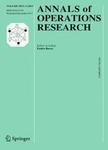版权所有:内蒙古大学图书馆 技术提供:维普资讯• 智图
内蒙古自治区呼和浩特市赛罕区大学西街235号 邮编: 010021

作者机构:Univ Sao Paulo Polytech Sch Dept Prod Engn Ave Prof Luciano Gualberto1380Cidade Univ BR-05508010 Sao Paulo SP Brazil Univ Fed Sao Paulo Ave Cesare Mansueto Giulio Lattes 1201 BR-12247014 Sao Jose Dos Campos SP Brazil
出 版 物:《ANNALS OF OPERATIONS RESEARCH》 (Ann. Oper. Res.)
年 卷 期:2025年第346卷第2期
页 面:945-980页
核心收录:
学科分类:1201[管理学-管理科学与工程(可授管理学、工学学位)] 07[理学] 070104[理学-应用数学] 0701[理学-数学]
基 金:FAPESP [2013/07375-0, 22/05803-3, 2022/06747-0, 2018/15417-8] CNPq [311536/2020-4, 312747/2021-7]
主 题:Routing and scheduling technicians Multi-objective Biased random-key genetic algorithm Q-Learning
摘 要:This work addresses a practical problem concerning the daily scheduling of tasks for field technicians and route planning, taking into account time windows, task priority, technicians skills, working hours, and lunch breaks. In line with the demands and expectations of large cities customers, we pursue two goals simultaneously: to maximize the weighted sum of the attended tasks and to perform the highest-priority tasks as soon as possible within their time windows. This is done without disregarding the fact that more efficient routes reduce fuel consumption. This paper presents a bi-objective mixed integer programming model for the problem and introduces an innovative approach that combines a multi-objective BRKGA with the Q-Learning method. Q-Learning is a reinforcement learning method that controls the parameters of the BRKGA during the evolutionary process, learning the best configuration based on rewards. Extensive numerical experiments and comparisons with the Nondominated Sorting Genetic Algorithm II and the Strength Pareto Evolutionary Algorithm 2 show that the proposed multi-objective biased random-key genetic algorithm outperforms the other approaches in instances with up to 200 tasks and 30 technicians, which are typical instances encountered in practice. The developed approach facilitates parameter calibration and consistently attains a substantial portion of the Pareto frontier in the multi-objective STRSP.